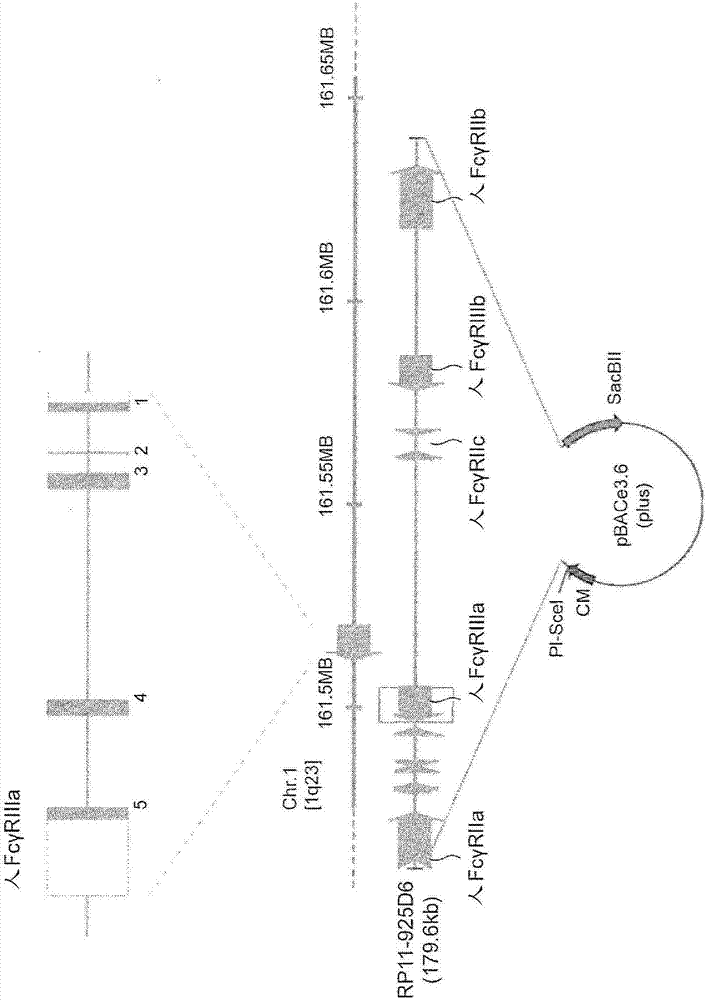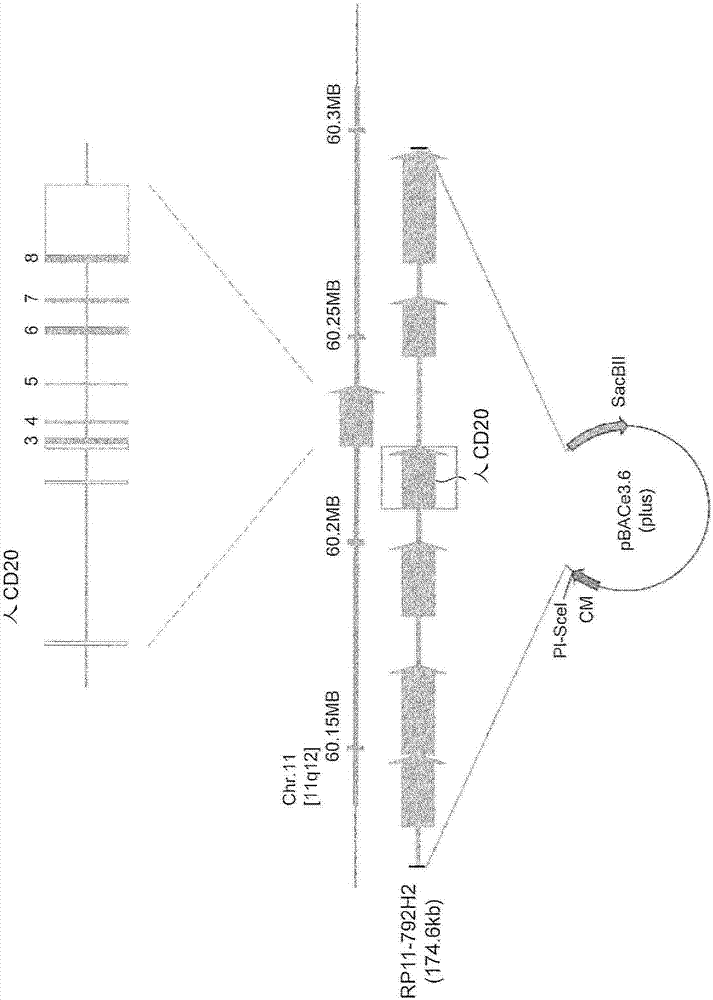Transgenic non-human animal expressing human-specific molecules and human FC gamma RECEPTOR FAMILY
A non-human animal, transgenic technology, applied in the direction of specific peptides, receptors/cell surface antigens/cell surface determinants, genetic engineering, etc., can solve the function, effectiveness and safety evaluation of pharmaceuticals in animal models, without using disease models Non-clinical test methods, problems with evaluation safety, etc., to achieve high-sensitivity results
- Summary
- Abstract
- Description
- Claims
- Application Information
AI Technical Summary
Problems solved by technology
Method used
Image
Examples
Embodiment 1
[0109] Example 1: Selection of BACs comprising gene clusters of the human Fcγ receptor family
[0110] Based on the cDNA sequences of human FcγRIIa, IIb, IIc, IIIa, and IIIb genes (GenBank: BC019931, BC031992, BC137397, BC017865, and BC128562), the human genome sequence was retrieved using UCSC GenomeBrowser, and the sequences containing these genes were found. BAC clones of all gene clusters of the human Fcγ receptor family. As a result, RP11-925D6 (Advanced Geno Techs Co.) with a size of 179.6 kb including the entire genomic DNA sequence of the human FcγRIIa, IIb, IIc, IIIa, and IIIb genes was identified and obtained, and it was used as the gene cluster BAC of the human Fcγ receptor family Expression vector( figure 1 ).
Embodiment 2
[0111] Example 2: Selection of BACs comprising the genomic sequences of the human CD20 and mouse CD20 genes
[0112]Based on the cDNA sequence of the mouse CD20 gene (GenBank: BC028322), the mouse genome DNA sequence was retrieved using the UCSC genome browser, and the mouse CD20 gene was found to be located in the 198.19cM region of chromosome 19. Comparison of the cDNA sequence of the mouse CD20 gene with the mouse genome sequence shows that the coding region of the mouse CD20 gene is also encoded by 7 exons in the entire 15 kb genome sequence.
[0113] Then, find the BAC clone encoding the mouse CD20 locus, identify and obtain the genomic DNA sequence of the mouse CD20 locus, the 111 kb genome sequence of the 5' upstream and the 83 kb genome sequence of the 3' downstream chromosome 19 209.9kb covered BAC clone RP23-117H19 ( figure 2 ) (Advanced Geno Techs Co.). According to the above gene information, it can be considered that the 209.9 kb BAC clone RP23-117H19 contains ...
Embodiment 3
[0115] Embodiment 3: Construction of the recombinant BAC expression vector of human CD20 gene
[0116] When constructing the recombinant BAC expression vector of the human CD20 gene, the sequence of intron 4 of the human CD20 gene of the human CD20 gene shown below, the human CD20 gene from the translation initiation codon to the termination codon of the human CD20 gene The sequences of both ends of the genomic DNA sequence, and the 3' side end and 5' side end of the mouse CD20 gene genomic DNA sequence from the translation start codon to the stop codon of the CD20 gene cloned from the mouse BAC were used as Key sequences for active homologous recombination reactions.
[0117] CD20-H1:
[0118] 5'-ATGACAACACCCAGAAATTCAGTAAATGGGACTTTCCCGGCAGAGCCAAT-3' (SEQ ID NO: 1)
[0119] CD20-H2:
[0120] 5'-CTCCCCAAGATCAGGAATCCTCACCAATAGAAAATGACAGCTCTCCTTAA-3' (SEQ ID NO: 2)
[0121] CD20-H3:
[0122] 5'-CCTAGACATTTAGACTAGATAGCAAGATGTTTTGGAAAGCAAGAGGCAGC-3' (SEQ ID NO: 3)
[0123] CD...
PUM
 Login to View More
Login to View More Abstract
Description
Claims
Application Information
 Login to View More
Login to View More - R&D
- Intellectual Property
- Life Sciences
- Materials
- Tech Scout
- Unparalleled Data Quality
- Higher Quality Content
- 60% Fewer Hallucinations
Browse by: Latest US Patents, China's latest patents, Technical Efficacy Thesaurus, Application Domain, Technology Topic, Popular Technical Reports.
© 2025 PatSnap. All rights reserved.Legal|Privacy policy|Modern Slavery Act Transparency Statement|Sitemap|About US| Contact US: help@patsnap.com



